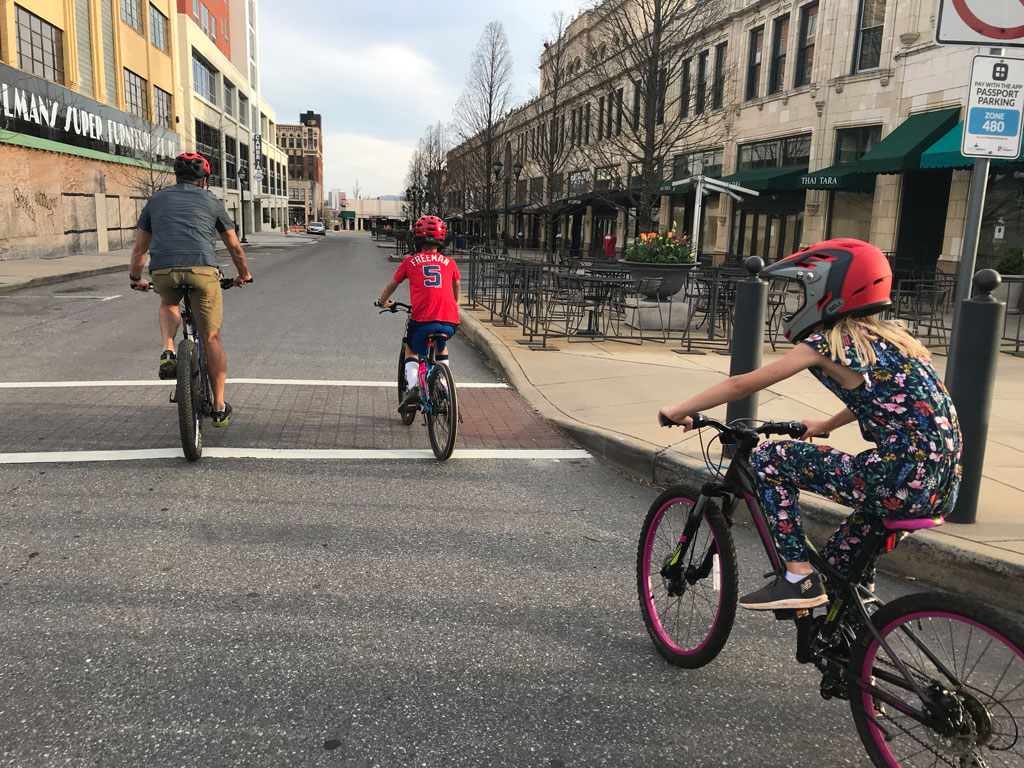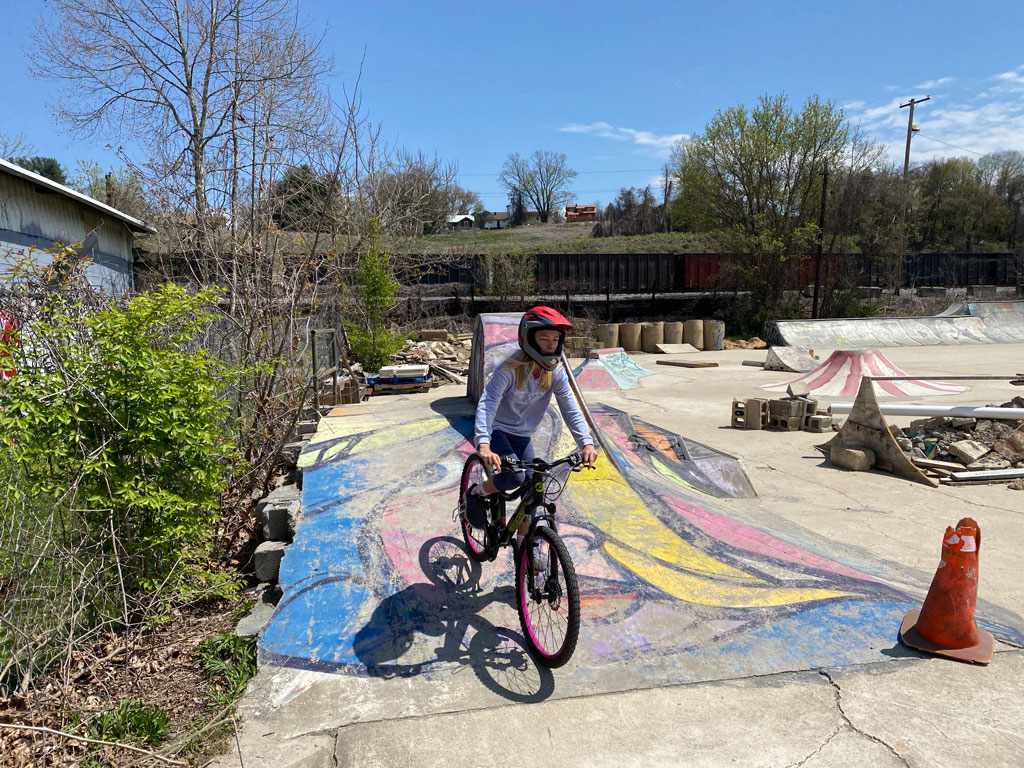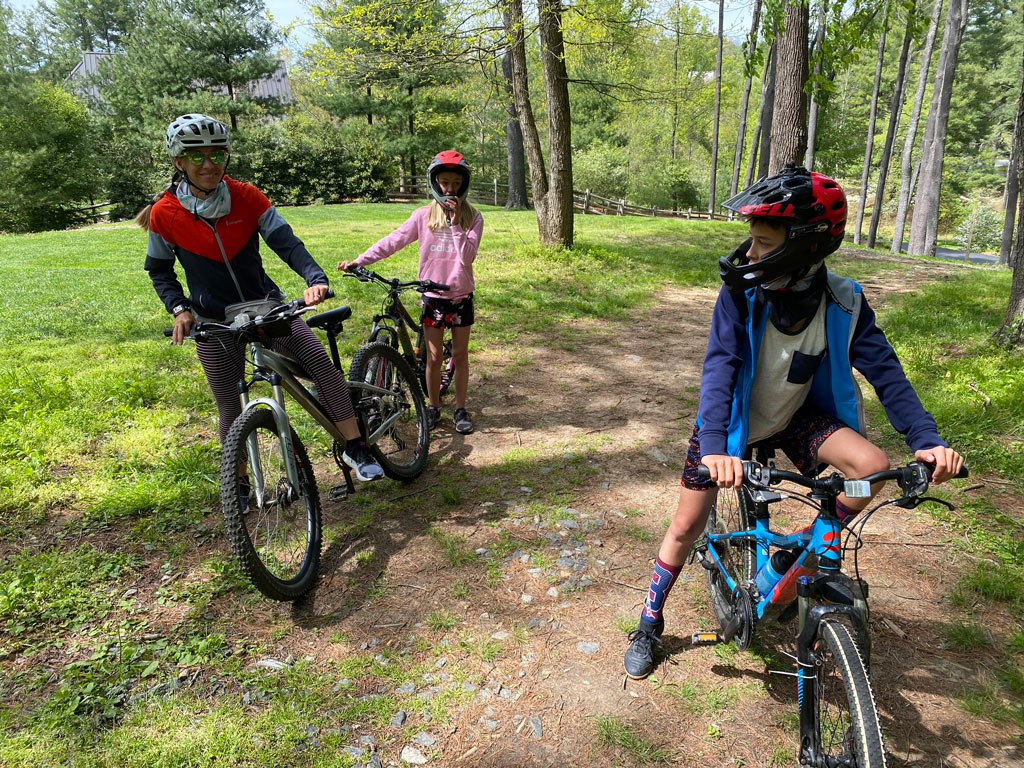My manual needs work. Watch a biker who can perform a good manual, where the front wheel of the bike stays off the ground in a perpetual wheelie, and it’s a thing of beauty—like that biker is toying with the natural laws of gravity. When I attempt this trick, it’s short-lived, a few seconds on my best day, and then I come crashing down to earth. But I keep working on it, trying to lift my front wheel in the air for a little bit longer than the last time as my kids and I pedal down the street, wandering aimlessly through our Asheville, North Carolina, neighborhood on our bikes. Maybe we’ll check out the vacant corner lot where there’s a particularly sweet tangle of roots we like to jump. Maybe we’ll cruise the greenway at the bottom of the hill.
There was a time—when was it, a few months ago? a year ago?—when I rode mountain bikes with other adults. We would gather mid-week and head out single file into Pisgah National Forest, a large swath of the Southern Appalachians known for its steep slopes, rooty trails and hidden waterfalls, racing each other up hills and handing out high fives and cans of beer … basically all the things you can’t do during social distancing protocols. The group ride, which had been in operation for more than a decade, was full of its own customs and lore. You weren’t allowed to leave anyone behind on the climb, and it was poor form to go home without having a beer in the parking lot. We told the same stories over and over, like the one about our buddy who left us in the middle of a ride, simply by saying, “I got a lasagna in the oven.” The phrase became a code for any unceremonious exit. “Where did Jeremiah go?” “Oh, he had a lasagna in the oven.” That weekly tradition is one of the many things I’m missing amid our current situation.

The author and his kids exploring downtown Asheville, a ghost town during the tightest COVID-19 restrictions.
These days during the pandemic, my group rides consist of my 11-year-old twins and me. Before our rides—daily if the weather allows—they put on their full-face helmets (a requirement after some dental trauma a couple of years ago) and then we cruise, looking for adventure.
The riding is completely different than the way I biked before. Instead of covering miles, we weave through downtown, searching for as many graffiti murals as we can find on a single trip. Rather than gunning for a certain average pace or total vertical feet, we comb the neighborhood for the sickest jump we can hit, and return again and again, until we’ve milked it for every bit of air it can deliver.
I’m convinced that riding with my kids is going to make me a better mountain biker in the long run.
Kids don’t care about vertical feet or heart rate zones. Kids care about riding to the next mailbox without touching the handlebars and pulling off trackstands, where you balance on your bike without moving, at a stop sign.
In the early days of the pandemic, it took me some time to abandon my Strava mindset and get used to the new pace. My stats have taken a hit for now, but I’m convinced that riding with my kids is going to make me a better mountain biker in the long run.
Although I rode bikes when I was young, it was a 10-speed and I kept the wheels planted firmly on the ground. I didn’t know what a trackstand was. I didn’t ride BMX like a lot of kids did in the ‘80s. As soon as I was old enough to get a driver’s license, I ditched the bike completely until I was in my early 30s and started mountain biking out of some vague notion that it was time to “get healthy.” Now, I’m learning these tricks for the first time right along with my kids.
“That’s actually pretty common,” says pro mountain biker Jeff Lenosky. “A lot of people don’t get into biking until they’re adults, so they bypass having fun on a bike. It’s all about fitness and keeping up on group rides for them, but those tricks some people learn as a kid form the foundation for a lot of mountain bike skills.”
Lenosky knows how to do all the tricks. He’s made his living as a freeride and trials mountain biker, an extremely technical and creative kind of riding that requires unbelievable balance and gymnastics-like moves. He even holds a Guinness World Records title for highest bunny hop on a full-suspension bike.
“Watch how kids ride bikes,” Lenosky says. “It’s just play for them. They find something they want to do, like ride a log or do a jump, and they stop and session it. We should all do that more often.”

Addie, who always wears a full face helmet, rides the skate park on the edge of town.
That’s exactly what this pandemic is forcing me to do—to slow down and ride my bike like a kid again. It’s less of a bike “ride” and more of a bike “session.” We never venture more than a few miles from our house, but we can spend hours pedaling the neighborhood. Mostly I just follow my kids around because they have a knack for finding fun features that I would typically ride past without even noticing—a low rock wall perfect for practicing drops or a set of stairs leading into a park that’s ideal for lapping.
My daughter will bring a speaker and we’ll listen to The Beach Boys while we ride. It’s festive. Sometimes, we don’t even leave the backyard. My son and I will have trackstand challenges on the driveway, where we try to outlast the other. We’re working on our bunny hops (my son has a hard time getting his back wheel off the ground) and our manuals (I have a hard time keeping my front tire off the ground). I’m spending more time on my bike than ever before and pedaling less miles. And I’m having a hell of a lot of fun.
“Everyone wants to go fast when they ride bikes but being able to stand still is [key],” Lenosky says, adding that having a good trackstand is the one essential skill that all mountain bikers need. “Having that ability to balance while standing still for an extra split second will save you in a lot of different situations.”
The trackstand will help with technical climbs, which are all over my local trails in Pisgah National Forest, so I’m particularly psyched to master this skill. And the beauty of this particular trick is you can practice it without leaving your yard.
“It’s really hard at first, but try it a few times and it becomes simple,” Lenosky says.
That seems to be the rule for most of the skills I’ve been working on since my 11-year-olds took over my group rides. Manuals are getting a little easier and I’m certain that one day, I’ll be able to hold one all the way from our driveway to the next mailbox.

The author’s family (Liz, Cooper and Addie) takes a break while exploring a small trail system at the bottom of their neighborhood.
I don’t know how long social distance protocols will last. Maybe more disconcerting is the fact that I don’t really know how much longer my kids are going to want to ride bikes with me. Parenthood is full of uncertainty like that. The biking helps with all of it. It keeps us active and busy in the midst of all the turmoil and gives me a chance to connect with my kids while they’ll still tolerate my presence. Having something silly to focus on like mastering a new trick gives our days a little purpose. And now my new group ride has its own customs and lore to tell—we get post-ride ice cream and talk about the time a series of squirrels darted in front of my son’s front tire. And if honing some of these basic skills as an adult will mean I can slay my friends when group rides commence, that’s just a bonus.
All photos courtesy Graham Averill
